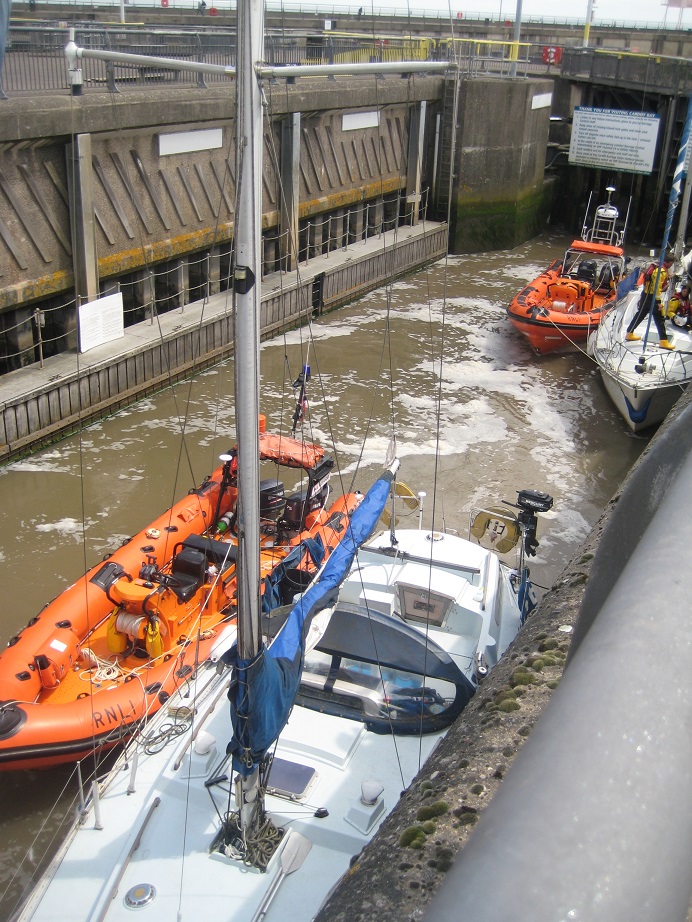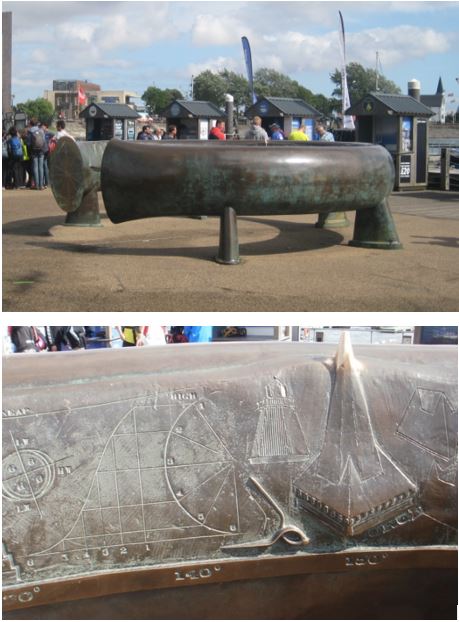Hello, Mrs Hg137 here.

It was Saturday 20th July, the first full day of our weekend break in Cardiff. We caught the train to Penarth, planning to walk back to Cardiff, see the bay and the barrage, take in the city centre, and find a cache or two along the way.

After a short walk downhill from the station through pleasant parkland (they like their topiary and flowerbeds here!) we arrived at the promenade. It was high tide, with no beach visible, so we set out along the pier https://piers.org.uk/pier/penarth/ The pier is great and there’s lots to say about it:
– We saw the Penarth All Stars netball team in pre-season training on the pier https://www.penarthtimes.co.uk/sport/17757201.national-success-penarth-allstars-netball-club/ and a few years ago, Gareth Bale was spotted playing football there https://www.bbc.co.uk/news/uk-wales-south-east-wales-28029379 And there’s a plaque commemorating a lady from Penarth who swam across the Bristol Channel to Weston-super-Mare http://www.dai-sport.com/91-years-ago-woman-porthcawl-made-swimming-history/

– It’s 658 feet long; it can’t be longer, or it would protrude into the shipping channel for Cardiff Bay. Paddle steamers – the Waverley and Balmoral – still dock at the pier.
– It was ‘Pier of the Year’ in 2014.
– There used to be another pier at the other end of the esplanade but that was destroyed by fire.
– When there are especially high spring tides, the water is almost up to the decking on the pier.
Having lingered on the pier, we started on the caching. The first cache we attempted was a multicache, ‘Penarth Prom’. To find it, we needed to collect and count numbers from signs and plaques from various places along the seafront. Having done that, the coordinates we derived led us to a plausible place and to a spot which matched the hint (and which looks correct now we have viewed other photos). But could we find the cache? NO! Not a good start. At this time there was sudden activity at the far end of the promenade; the road closed, briefly, as the Penarth lifeboat was launched and went zooming out to sea; more about this later.
We gave up on the unfound cache and began to walk back to Cardiff, arriving at a viewpoint at the top of the cliffs with a big view back to the pier and beyond to Flat Holm and Steep Holm islands. The boundary between Wales and England runs between the islands; Steep Holm, the farthest one, is English, while Flat Holm is Welsh. Here, also, is a cache, newly placed, somewhere around a wall at the lower end of the viewpoint. That gives littles away as the concrete wall has various lumps, bumps, cracks, and fixings, and ivy trailing over and through it. We had ample time to consider all of those as we searched up and back and along the wall, sticking our fingers in myriad places, and we were just getting downhearted when I spotted something ever so slightly different, which was the cache. Hooray, a find to get us going.

There was a short, winding descent and we emerged at the locks at one end of the barrage. After crossing the three locks, each with their own lift bridge, we were about to walk away when we saw “boats” approaching the locks. Ooh – a chance to see the locks work and the bridge lift! We went back to the locks to see what would happen. And “boats” was a yacht roped to a RNLI lifeboat. Another yacht roped to another lifeboat soon followed, and then a smaller lifeboat, keeping watch. The two pairs of yachts/lifeboats manoeuvered into the lock, leaving the littlest lifeboat outside. What was going on, and why do many lifeboats? As the lock filled, the lock-keeper told us that a yacht had broken down in the Bristol Channel and was taken in tow by the Weston lifeboat. The Penarth lifeboat, which we saw leaving earlier, went to collect it to return it to Cardiff, but was called to another broken-down yacht on the way. All yachts and lifeboats then returned to Cardiff and made their way into the bay, with a bit of RNLI crew swapping as the Weston RNLI crew weren’t familiar with the locks. What excitement! Read all about it here: https://www.thewestonmercury.co.uk/news/weston-rnli-tow-yacht-to-cardiff-1-6174628

Once across the locks, we were in Cardiff. Croeso i Caerdydd! We stopped almost immediately to find the Southernmost Point of Cardiff cache, hidden on the end of the breakwater; this one was hard to find, with fingertip searches of every likely hiding place. Then followed a cacheless walk of about a mile along the barrage and the shores of Cardiff Bay. It was now warm, but quite windy, and the waves in the bay were sparkling, though doubtless the water was cold.

Part way along, we came to a floating assault course – think “Total Wipeout”! – and we watched a party of exhausted participants drag themselves from the water while the next group rushed excitedly in https://www.aquaparkgroup.co.uk/cardiff/
We passed the Norwegian Church (Roald Dahl was baptised here), and next reached outer space – the “Doctor Who Experience” had been located here until recently, and our next pair of caches had Whovian themes – “Bigger on the Inside” and “Don’t Blink”. Passing Britannia Quay, we found two more caches (at last, the total was beginning to build now, after a slow start to the day). We’d reached the Senedd, the National Assembly for Wales http://www.assembly.wales/en/visiting/senedd/Pages/senedd.aspx and decided on a quick look inside. Mistake! We had to go through security: Mr Hg137 almost had to disrobe (??!?), while I had to hand in my weapons (a Swiss Army knife and a torch): we had a look around but we didn’t feel especially welcome.
Weapons reclaimed, we returned to the shores of the bay to look for “Goldfinger Revisited”. We weren’t quite sure what this was going to be, and were surprised to arrive at a large sculpture, the Celtic Ring http://harveyhood.blogspot.com/2011/11/celtic-ring-cardiff-bay.html The other surprise (to us, anyway) was that the area was incredibly busy, but it was a sunny weekend afternoon, down by the water, with a nearby funfair, so maybe (a few!) people are to be expected … We thought for a bit, read cache logs, hint, and description, and soon found the cache, without any of the crowd spotting us.
We continued into an area now called Cardiff Bay, but which used to be called Tiger Bay, which was a very … umm … vibrant area of the city. https://en.wikipedia.org/wiki/Tiger_Bay We stopped to find the Sidetracked cache at Cardiff Bay station. After the quick find, we stopped to regroup, around the corner, for a moment, then stepped back into the sunshine to find … some other cachers replacing the cache! Nice to meet you, new-dawn and two mini-cachers! They said they had come into town for the day, and that they had found a new cache on the barrage called “Captain Fartypants” … we had walked right past it … and the cache hadn’t been placed when we loaded the caches for this weekend. Curses!
A little further on, there was another cache for us to find, outside St. Mary’s Church, called “Tiger Bay Girl Was Here” – Shirley Bassey, the girl in the title, was baptised there.
Then we reached the southern edge of the city centre – almost back now! – to do two earthcaches, close to each other, in quick succession: these require you to gather geological information from items in the area. So close to each other, so different in aspect: Callaghan Square was a breezy open space with fountains and skateboarders: St. Mary’s Street was party central, and maybe 5pm on a sunny Saturday wasn’t the best of times to attempt this cache. The area was quite … lively! We sat on a bench and assembled the answers, unnoticed, while hen parties, stag parties, and party parties all passed by.
And that was it – back to the hotel. A little later, after a rest and a superb Chinese meal in a restaurant where we were almost the only Europeans, there was one final cache to attempt, the Sidetracked at Queen Street station, opposite our hotel. We finished the day as we had started, with a failure. The cache is hidden somewhere along a wall around a private car park. Mr Hg137 decided to search inside the car park (foolish), but became trapped when the automatic gates shut on him (oops); luckily, he got a concierge to let him out through the foyer of some nearby apartments. A quirky end to a fascinating, but tiring day, and we had seen a huge variety of what Cardiff has to offer.
(Editor’s note: if you are in the area, the restaurant is No. 23 Chinese Restaurant 金满楼 in Churchill Way)

























